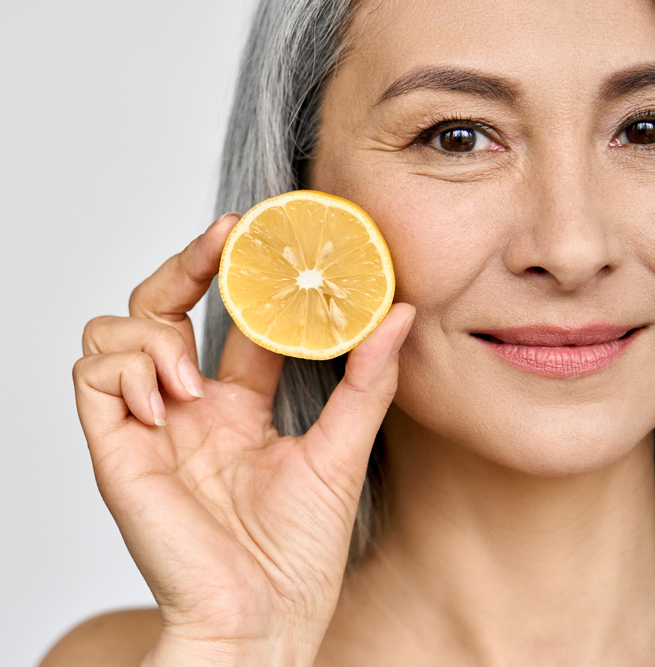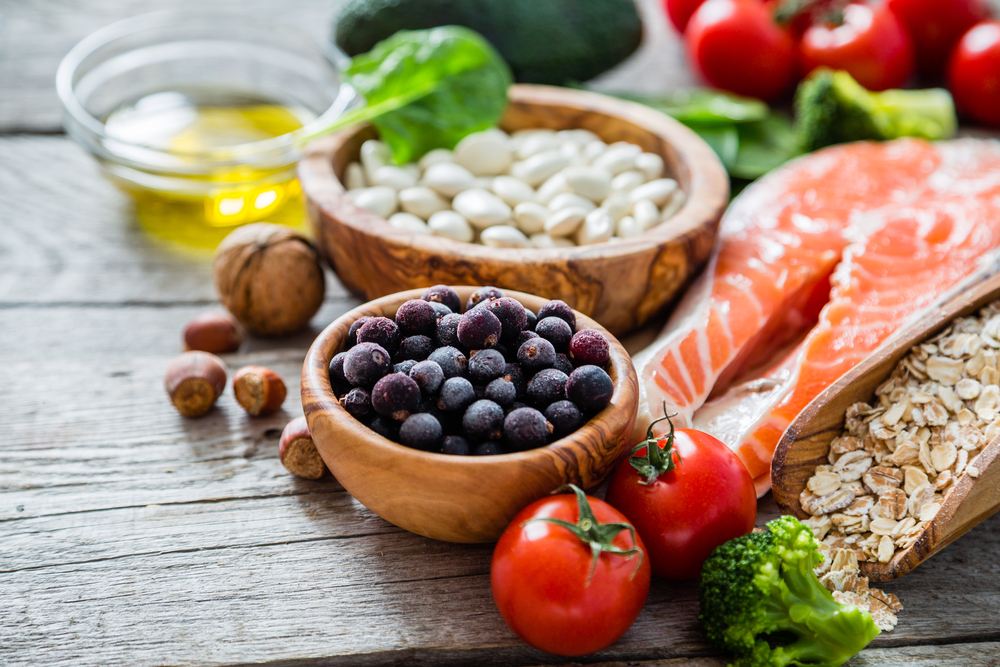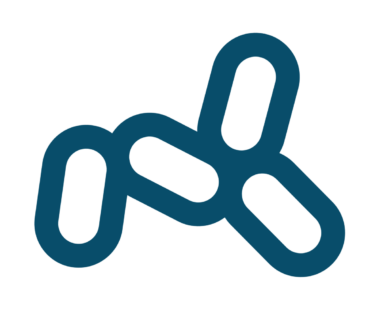Nutraceutical
We recognize, and may occasionally use, the term nutraceutical, which comes from two words: “nutrient” (food component) and “pharmaceutical” (medical drug), to reflect the use of foods, parts of foods, and botanicals that claim to provide medical or health benefits, including the treatment of menopausal transition symptoms. Similarly, we use the term functional foods to describe foods that may offer health benefits in addition to their basic nutritional value. Fruits and veggies, which are nutrient-rich, are functional foods as are foods that have been fortified with vitamins, minerals, probiotics, and/or fiber.
Menopause & Nutrition
Nutritional choices cannot ‘un-age’ you – but healthy choices can compensate for the impacts of your natural menopausal transition by helping to influence individual symptoms that are affecting you.
Additionally, healthy nutrition can prevent, delay and treat the onset of many symptoms, improving the aging experience. For example, as our bodies enter the menopausal transition, hormone production (Hormones101) fluctuates a lot (Menopause101) and we can experience many changes to our bodies including (but not limited to) weight gain; abdominal issues; bone loss; cognitive decline, and sexual changes. Below we give a short summary of research on nutrition as it impacts menopausal transition changes.
A 2019 study by Dunneram et al. looked at how diet can influence the age at which a woman reaches menopause (defined as one full year without a period). The key findings included the fact that a high daily individual intake of oily fish, fresh legumes, vitamin B6, and zinc was associated with a delayed onset of menopause, whereas a high daily intake of refined pasta or rice was associated with an earlier onset of menopause. Women who self-report as vegetarians were found to have an earlier menopause onset age relative to non-vegetarians. The advantages of a later age at menopause is found in the extra time that women benefit from high levels of estrogen, lowering their risk of osteoporosis and heart disease. This same study also noted, however, that an earlier age at the onset of menopause is associated with lower risk of breast, endometrial, and ovarian cancers. [27]

Nutrition Recommendations for Menopause
Any nutrition plan that focuses on fish, whole grains, fruits, vegetables, olive oil and lean meats while limiting salt intake, sweets, processed foods, refined carbohydrates, and sugar loaded drinks is optimal during the menopausal transition. Low-fat and plant-based diets (vegan and vegetarian) are associated with heart health benefits and beneficial effects on body composition. However, they may require supplementation with vitamin B12, micronutrients like iron and omega-3 fatty acids. [1]
There are multiple ‘diet’ plans that meet these requirements easily available. You can ask your healthcare provider for recommendations, do your own research, or consult a certified Nutritionist to create your individualized plan based on your preferences and food intolerances to make this a more sustainable approach. Three well-known food plans, or ‘diets’ also fit the requirements – The DASH diet (dietary approach to stop hypertension), the Mediterranean diet (MD), and the MIND diet (Mediterranean-DASH intervention for Neurodegenerative Delay), but they are not the only choices. These three diets, or others that decrease processed food intake and increase vegetable, fruit, whole grain and lean proteins, should help the primary prevention of bone, metabolic, and cardiovascular diseases in the postmenopausal period. [1a]
Phytoestrogens are natural substances that include isoflavones, lignans, coumestans, stilbenes, and flavonoids. Plant-based diets, especially those that include soy products, are rich in phytoestrogens. Studies support the idea that phytoestrogens can improve many symptoms seen during the menopause transition, including reducing hot flashes.[2] However, as with any nutritional supplement, talk to your health care provider before using them, particularly to ensure there are no interactions with other medications or supplements you are taking.

The Science
MYTH
One paper did find that vegetarians have an earlier menopausal transition onset and that higher meat consumption was associated with delayed onset of menopause in a group of women between 45 and 49 years of age [27]. However, another paper found that there might be a delay in onset of menopause transition by eating lots of vegetables. [26]
MYTH
While adequate water intake is critical for overall health, 8 glasses is not a hard and fast requirement. Women usually get water from multiple different sources, including hydrated foods like fruits and vegetables.
MYTH
Healthy weights can be obtained and maintained! While the metabolism does slow down during the menopausal transition, metabolism is still happening. Adequate exercise and maintaining healthy eating habits empowers women to control their weight.
Nutritional Recommendations
How many calories, which are units of energy, are needed per day depends on a person’s level of physical activity, age and height. Middle-aged and older women need fewer calories than younger women. Active women need more energy than sedentary women. Nutrition scientists recommend 1600 calories per day for weight maintenance.
Cholesterol
less than 300 mg/day
Fiber
25-30 g/day
Protein
10-35% of daily calories
Carbohydrates
45-60% of daily calories
Sodium
less than 2400 mg/day
Compiled References
- Weikert, C 2020: Vitamin and Mineral Status in a Vegan Diet. Dtsch Arztebl Int. 117(35-36):575-582.
- Franco OH, Chowdhury R, Troup J, et al. Use of Plant-Based Therapies and Menopausal Symptoms: A Systematic Review and Meta-analysis. JAMA. 2016;315(23):2554–2563. doi:10.1001/jama.2016.8012
- Al-Anazi AF, Qureshi VF, Javaid K, Qureshi S. Preventive effects of phytoestrogens against postmenopausal osteoporosis as compared to the available therapeutic choices: An overview. J Nat Sci Biol Med. 2011;2(2):154-163. doi:10.4103/0976-9668.92322
- El Khoudary, S.,, B., Beckie, T.M., Hodis, H.N., Johnson, A.E., Langer,R.D. Marian C Limacher,M.C., Manson, J. E., Aggarwal Stefanick, M.L., Allison, M.A. (2020), CirculationVolume 142, Issue 25: Menopause Transition and Cardiovascular Disease Risk: Implications for Timing of Early Prevention: A Scientific Statement From the American Heart Association
- Campos H, McNamara JR, Wilson PWF, Ordovas JM, Schaefer EJ. (1988) Differences in low density lipoprotein sub fractions and apolipopro- teins in premenopausal and postmenopausal women. J Clin Endocrinol Metab 1988;67:30-35.
- Bittner V. (2002) Lipoprotein abnormalities related to women’s health. Am J Cardiol. 2002; 90: 77i–84i.
- Schnatz PF, Schnatz JD, Dyslipidemia in menopause: mechanisms and management, Obstet Gynecol Surv, 2006;61(9):608–13.
- Williams CM, Lipid metabolism in women, Proc Nutr Soc, 2004;63(1):153–60
- Rosano GMC, et al., Menopause and cardiovascular disease: the evidence, Climacteric, 2007;10(1):19–24
- Kannel WB, Levy D, Menopause, hormones and cardiovascular vulnerability in women, Arch Intern Med, 2004;164:479–81
- Kannel WB, Levy D, Menopause, hormones and cardiovascular vulnerability in women, Arch Intern Med, 2004;164:479–81
- Granic, A.; Sayer, A.A.; Robinson, S.M. (2019) Dietary Patterns, Skeletal Muscle Health, and Sarcopenia in Older Adults. Nutrients 2019, 11, 745.)
- Granic, A.; Sayer, A.A.; Robinson, S.M. (2019) Dietary Patterns, Skeletal Muscle Health, and Sarcopenia in Older Adults. Nutrients 2019, 11, 745. )
- Cano, A.; Marshall, S.; Zolfaroli, I.; Bitzer, J.; Ceausu, I.; Chedraui, P.; Durmusoglu, F.; Erkkola, R.; Goulis, D.G.; Hirschberg, A.L.; et al. (2020) The Mediterranean diet and menopausal health: An EMAS position statement. Maturitas 2020, 139, 90–97.)
- Kannel WB, McGhee DL, Diabetes and cardiovascular disease. The Framingham study, J Am Med Assoc, 1979;241:2035–8
- Farvid, M: Post-diagnostic dietary glycemic index, glycemic load, dietary insulin index, and insulin load and breast cancer survival (2021). Cancer Epidemiology, Biomarkers & Prevention.
- Eaton, S.A.; Sethi, J.K. Immunometabolic Links between Estrogen, Adipose Tissue and Female Reproductive Metabolism. (2019) Biology 2019, 8, 8.
- Nagata, C 2000: Association of diet with the onset of menopause in Japanese women. Am J Epidemiol. 152(9):863-7.
- Dunneram, Y 2019: Proc Nutr Soc 78(3):438-448.
- Lim EY, Lee SY, Shin HS, Lee J, Nam YD, Lee DO, Lee JY, Yeon SH, Son RH, Park CL, Heo YH, Kim YT. The Effect of Lactobacillus acidophilus YT1 (MENOLACTO) on Improving Menopausal Symptoms: A Randomized, Double-Blinded, Placebo-Controlled Clinical Trial. J Clin Med. 2020 Jul 9;9(7):2173. doi: 10.3390/jcm9072173. PMID: 32660010; PMCID: PMC7408745.





